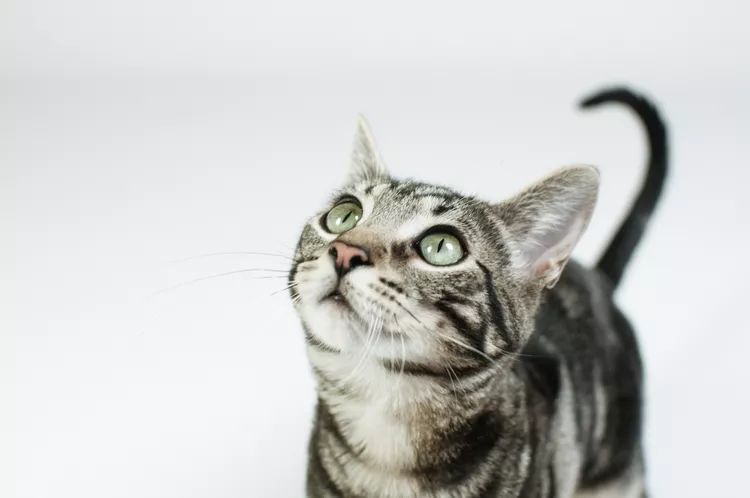Are Cats Color Blind?

Cats are color blind, but they can likely see some colors. Color blindness comes in several forms and can affect humans as well as animals. Here's what science says about color blindness in cats.
What Is Color Blindness?
Color blindness is the lack of ability to discern certain colors from one another, but doesn’t mean you don’t see any color at all. In people, red-green color blindness is most common, affecting about 8% of men and 0.4% of women. Yellow-blue color blindness is less common type of color blindness in people. A third, rare type of color blindness is monochromatism, which means the person can only see black and white.
In the eye are two types of specialized cells: rods and cones. Rods aid in light vision while cones aid in color vision. People are known to have trichromatic vision, meaning they have three types of cones: one sensitive to red, one sensitive to blue, and one sensitive to green. These three types of cones allow us to see all the rainbow colors.
Color Blindness in Cats
In cats, color blindness is more challenging to understand because they can’t undergo color blindness tests that people can take. Cats were traditionally thought to have two types of cones in their eyes, giving them dichromatic vision. One is sensitive to shades of blue-violet and the other is sensitive to shades of yellow-green. This leaves blue-greens and reds as colors that cats might not be able to discern as easily as we can. Dichromatism in cats is thought to be most comparable to red-green color blindness in people where shades of blue-greens and reds appear more like gray.
There have been studies to determine if cats are trichromatic because three different types of cones have been observed in cats. This third type of cone may be sensitive to shades of cyan (blue-green). One study showed that cats might have something called photopic trichromatic vision. This means that cats may see a similar color spectrum to humans in daylight, but maybe not quite as vibrantly. So their world may appear more pastel-like than day-glo.
There are even studies into whether or not cats can see ultraviolet light. Urine trails can be seen by animals with UV vision, so this may be one reason cats house soil in the same spot over and over again (although a more likely reason is their powerful sense of smell).
Variations in Feline Color Blindness
Some cats may have even more limited color vision. Red-green color blindness, blue-yellow color blindness, and monochromatism are all inheritable traits in humans. Cats may have a similar, inheritable trait that further limits their color vision, but this has not been documented at this time.
Testing Color Vision in Cats
Cats can’t take color blindness tests like people, and there's no straightforward way to test a cat's color vision at this time. That is a large part of why there remain so many unknowns about what they see when it comes to colors.
Cat Vision vs. Human Vision
While we may have cats beat on color vision, it’s not all bad for them.
Cats are known to have many more rods in their eyes than people. Since rods aid in night vision and light sensitivity, this explains why cats can see so much better than we can in low light. Cats are crepuscular, meaning they are most active at dawn and dusk. Being able to discern color at these times isn’t as important as being able to see well in poor lighting.
Cats also have a wider field of vision than we do, spanning 200 degrees, whereas people only have a field of vision spanning 180 degrees. Cats may have a wider field of vision to make up for the fact that their vision isn’t believed to be quite as sharp as ours is. Cats would be best described as nearsighted. While most people can see things in sharp detail up to 200 feet away, cats really can only see things sharply up to 20 feet.
Cats, like us, have front-facing eyes, giving them a larger portion of binocular vision as opposed to uniocular vision. Binocular vision is what allows for depth perception, which is an important adaptation for being able to catch prey.
How Color Blindness Affects Cats
Since we don’t fully understand cat vision, it’s hard to discern the extent of their color vision and what limitations may exist. While they likely don’t see the visible light spectrum the way we do, the inability to discern certain colors is normal for cats.
Cats certainly can have favorite toys and preferred beds and this may lead owners to suspect their preference is based on what colors they can (or cannot) see. However, they could love that toy or blanket for any number of reasons. Some purport that cats don’t react to toys if they are a color they can't see, such as red or yellow. But not being able to discern a specific color is far different than not being able to see at all. A red toy may not appear red to your cat, but they will still be able to see it and they may still play with it.
Color Considerations for Cats
Cats may not see like humans, but that certainly doesn’t impede their vision. Most cats live a happy, healthy life, regardless of their ability, or inability, to see specific colors.
Because color blindness in cats is normal for them, there’s no need for concern and nothing to treat. Any cat owner will tell you that their cat is not impeded by its limited color vision. Cats have so many other special vision features that they often see things we don't.